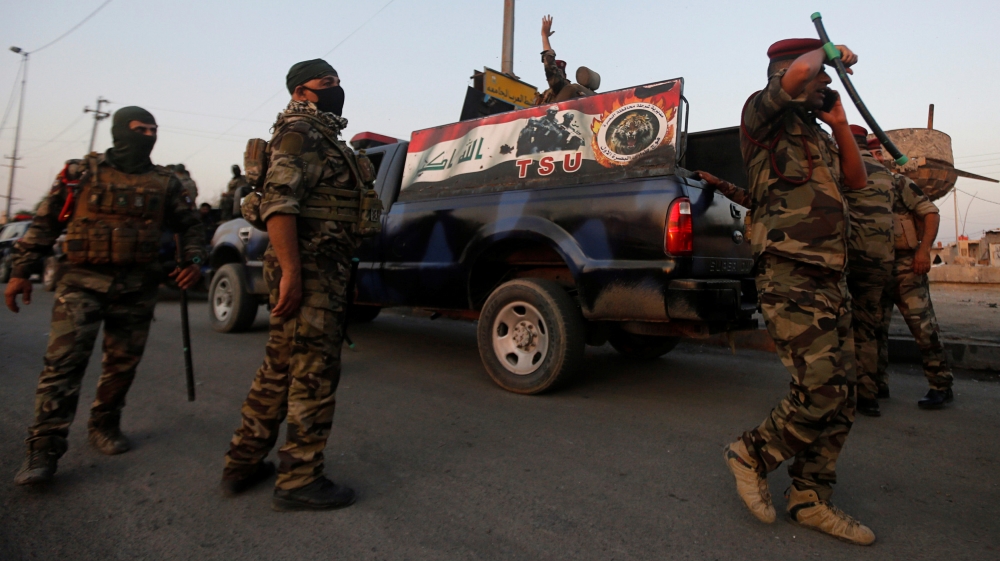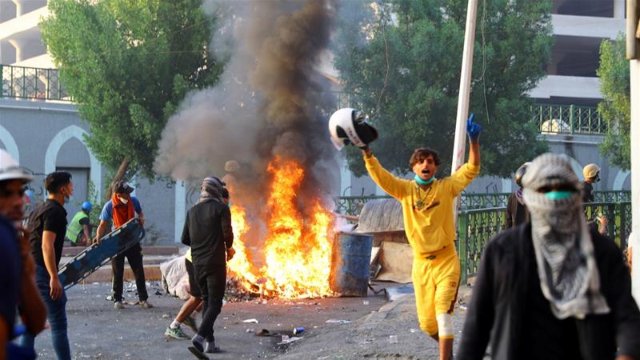Iraqi security forces in Baghdad have fired tear gas at demonstrators and erected concrete barriers in a bid to block their movement, a day after forcefully clearing protest sites in a security operation that killed at least six protesters in the capital.
The deaths on Saturday brought the toll since the protests began in early October to more than 260, with security forces using live fire, rubber bullets and tear gas to quell the sweeping demonstrations in Baghdad and several southern cities against the country’s ruling elite.
In a statement late on Saturday, Amnesty International described it as a “bloodbath” and called on the Iraqi government to rein in security forces.
“The government of Iraq has a duty to protect its people’s right to life, as well as to gather and express their views. This bloodbath must stop now, and those responsible for it must be brought to justice,” Heba Morayef, Amnesty International’s Middle East and North Africa Director, said.
“Iraqi authorities must immediately order an end to this relentless, unlawful use of lethal force.”
The crackdown began on Saturday morning when security forces tried to wrest back control of three bridges spanning the River Tigris in the heart of Baghdad.
Iraqi forces then moved towards Tahrir Square, the hub for the weeks-long protest movement, firing live rounds and tear gas.
On Saturday evening, Al Jazeera saw at least 10 young male protesters being treated for tear gas inhalation in less than one hour in one of the many clinics surrounding Tahrir Square. In one makeshift surgery room, two doctors removed plastic and metal shrapnel from a man’s leg. Overall, more than 100 people were wounded.
Medics who witnessed the police operation in Baghdad told Amnesty that four protesters had been shot dead with live ammunition, while two others succumbed to wounds resulting from tear gas grenades striking their heads.
Amnesty said there have been at least 264 protester deaths across the country in little over a month, while other tallies, including one compiled by AFP news agency, put the death toll to around 300. The government has stopped issuing official figures. Officials also denied any protesters were killed on Saturday.

Security forces were also reported closing roads in the area with concrete barriers, trying to block protesters from reaching Tahrir Square and the Sanak bridge.
“Witnesses [said] that there are renewed clashes going on in an area on and around Sanak bridge, one of the bridges that leads from the area close to Tahrir Square to other heavily-fortified pars of Baghdad,” Al Jazeera’s Mohammed Jamjoom, reporting from Baghdad, said.
“Tension … is rising and people are concerned there could be more clashes throughout the day,” he added, noting that there were also reports of protests and clashes in the cities of Basra and Najaf.
In the southern city of Nasiriyah, security and medical officials said 31 people were wounded in confrontations outside the education directorate as security forces tear-gassed protesters trying to block employees from reaching the building in the city centre, according to The Associated Press news agency. Among those wounded were two school students, they said, speaking on condition of anonymity in line with regulations.
Atmosphere of intimidation
Since October 1, Iraqis have been pouring onto the streets to protest against corruption and the government’s failure to deliver basic services and economic opportunities.
The protesters’ demands have since widened to include the resignation of the government and a complete overhaul of the country’s political system, which was established after a US-led invasion that critics say has allowed certain individuals and groups to enrich themselves and expand their influence.
Rights groups and observers have also raised the alarm over the arrest and intimidation of activists and medics, who have reported being followed by unidentified security forces.
“The security forces see the doctor’s jacket and they shoot at them,” Bassam, a 25-year-old medic volunteer, who asked his real name not be used, told Al Jazeera.
According to the United Nations Assistance Mission for Iraq, six protesters or volunteers providing assistance in the Baghdad demonstrations have been abducted by unknown assailants.
One of them, 36-year-old volunteer and activist Saba al-Mahdawi, had been providing medical supplies in Tahrir Square on November 2 when she was taken on her way home from the protests. Her fate remains unknown.
Politician’s pledges
The use of excessive force by police and security forces has continued despite pledges by politicians to end the brutal crackdown on pro-democracy demonstrators.
Iraq’s embattled Prime Minister Adel Abdul Mahdi promised that the government and judiciary would continue to investigate the deaths, adding that all detainees who have been arrested in the past several weeks would be released.
In a statement released on Saturday, Abdul Mahdi said protestors must allow for a return to normal life.
The 77 year old also said that new electoral reforms would be announced in the “coming few days”, but fell short of giving further details.
The prime minister has previously promised a number of reforms, including stipends for the poor, more job opportunities for graduates and pledges to punish a handful of corrupt officials. But his remarks have done little to quell public anger.
Abdul Mahdi came to power last year through a shaky alliance between populist Shia leader Muqtada al-Sadr and Hadi al-Amiri, a leader of the Hashed al-Shaabi, or Popular Mobilisation Forces, paramilitary network.
He has refused to step down, but has said he is willing to resign if political leaders agree on a replacement, according to President Barham Salih.



